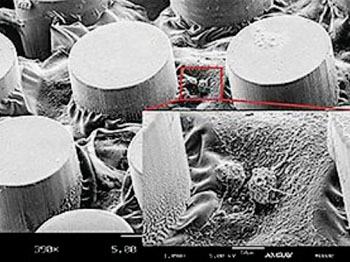Cell Culture Technique Leads to Tailor-Made Cancer Treatments
By LabMedica International staff writers
Posted on 05 Jan 2015
A novel in situ capture and culture methodology has been developed for ex vivo expansion of circulating tumor cells (CTCs) using a three dimensional co-culture model, simulating a tumor microenvironment to support tumor development.Posted on 05 Jan 2015
The potential utility of CTCs to guide clinical care in oncology patients has gained momentum with emerging micro- and nano-technologies and tumor progression and metastasis depends both on enumeration and on obtaining sufficient numbers of CTCs for downstream assays.

Image: Scanning electron microscope (SEM) photograph of fibroblasts in gel cultured on microfluidic chip (Photo courtesy of the University of Michigan).
Scientists at the University of Michigan (Ann Arbor, MI, USA) developed the capture and culture process with a microfluidic chip device that captures cancer cells as a blood sample is pumped across it. The team used a chip made of polydimethylsiloxane on a 1-inch by 3-inch glass slide. They covered the chip with microscopic posts that slow and trap cells, then coated it with antibodies that bind to the cancer cells.
Blood drawn from early lung cancer patients was flowed through the CTC-capture device at a flow rate of 1 mL/hour for 1 mL total for each device. After the cancer cells were captured on the chip, the team pumped in a growth medium mixture. They also added cancer-associated fibroblast cells. This created a three-dimensional environment that closely mimics the conditions inside the body of a cancer patient. After capture, cells also were fixed and immunofluorescently stained with labelled antibodies. The devices were scanned using a programmed inverted fluorescence microscope (Nikon, Melville, NY, USA). Positive and negative cells were designated as CTCs depending on the staining and enumerated.
The investigators used many other techniques including 3-D spheroid assays, invasion assays, sequencing, and real time polymerase chain reaction, (RT-PCR) which were analyzed on the ABI 7900HT instrument (Applied Biosystems; Foster City, CA; USA). After the cancer cells were captured on the chip, the team pumped in a mixture of collagen and Matrigel growth medium. The captured cancer cells prospered in the mixture, reproducing additional cells in 73% of tested samples. It was a dramatic improvement over earlier methods, which studied later-stage cancer patients and saw success rates of only around 20%.
Max S. Wicha, MD, distinguished professor of oncology, and coauthor of the study said, “The technology can be applied to most cancers, including breast, lung, pancreatic and others. It could enable doctors to follow the progression of each patient's disease much more closely. Cancer cells change constantly and they can quickly develop resistance to a given treatment. A device like this will enable us to follow the cancer's progression in real time. If a cancer develops resistance to one therapy, we'll be able to quickly change to a different treatment.” The study was published on December 1, 2014, in the journal Oncotarget.
Related Links:
University of Michigan
Nikon
Applied Biosystems














